
In April 2013, the Rana Plaza building collapse shocked the world. The near destruction of an entire Bangladeshi clothing factory resulted in 1,134 deaths. Well-known retail and fashion brands were caught up in the aftermath, as critics said the low-cost and short deadline demands of fast fashion contributed to the conditions in the suppliers’ factor which ultimately led to a loss of life.
Many companies acknowledged these problems by backing the Accord on Fire and Building Safety in Bangladesh. The move shows companies are trying to learn lessons from tragedies such as the Rana Plaza building collapse, but too often they are the wrong ones. Rather than reacting to problems after they occur, they need to understand their supply chains better, and foresees where the greatest risks will occur.
Supply chains hit the headlines for all kinds of reasons. It might be poor working conditions, modern-day slavery, conflict minerals, palm oil and a whole raft of environmental considerations. It might be covered by legislation, but equally, it might be determined by modern consumers – whether you are a consumer-facing business or not. So broad is the challenge that picking off these problems one by one, or responding to an issue only after having been shamed on the front page of the newspaper, is ineffective. It may be possible to gain executive support to address the issue that’s landed the organisation in hot water, but a purely reactive strategy to one key aspect of sustainability risk will not improve your ability to respond when the next sustainability issue rears its head, nor will that one key action on its own make you an ethical business.
We work with businesses around the world, to help them understand supply chain risk and work through a tailored strategy for sustainable procurement. Until quite recently, the best action we could hope for with many clients was to put a supply chain code of conduct in place and place all responsibility on the supplier to be compliant to that code conduct. Clearly, that approach is now insufficient.
In the first instance, many companies are not aware of their full exposure to the different types of environment, social and economic sustainability risks. They might read about palm oil and they think, “We don’t use any palm oil” so our risk is low. But if we ask them – ‘do you use computers or wear uniforms?’ they quickly come to the realisation the risks are broader than they first thought since in IT hardware there is a risk of using conflict minerals, while uniform suppliers have been found to have unethical working practices in their supply chains.
To create and implement a strategy for supply chain sustainability is a multi-stage process. A code of conduct is the starting point of defining what sustainable procurement is to an organisation, and it creates a platform to communicate expectations of suppliers. But it needs to go much further. We need to assess the categories of goods and services to understand inherent risk in the supply chain of individual organisations so that we can survey and audit in a targeted way, focusing primarily on the high risk areas. Once the key sustainability measures, and the inherent risks are understood, the supply chain needs to be mapped and surveyed. But to truly assess and start to mitigate risk, we can’t just focus on our immediate suppliers, as the true environmental, social, and human rights issues often lay with our suppliers’ suppliers, and our suppliers’ suppliers’ suppliers, hence why the issue is so complicated.
Remember that millennials – the growing cohort of consumers and employees – have a different view on ethics compared with many senior business figures. Socially minded millennials often choose not to buy brands associated with exploiting the environment or workers, but also, they choose not to work for those organisations either.
To create a governance model and process that reaches across the supply chain to mitigate a broad set of risks is a lot of work, but it is also an investment. Legislators, investors and consumers are increasingly interested in supply chain ethics and sustainability. The recent introduction of Modern Slavery in Australia and the UK in 2015 has elevated the discussion around modern slavery to the board room. The trend won’t stop with the latest story to hit the news. Investing now will help avoid risks and prepare for the future in meeting the expectations of the growing millennial consumer base as well as changing legislative requirements. In the long term, it will cost less than a piecemeal approach and, since customers are interested in engaging with ethical businesses, it will also help you win work.

